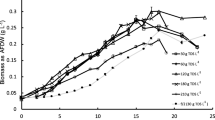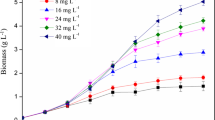Abstract
The culture protocol of Schizochytrium limacinum SR 21, a known docosahexaenoic acid (DHA) producing marine algae was modified in this study to better fit fermentation parameters, particularly control of dissolved oxygen (DO) to the known reproductive and growth biology of the microorganism. The cultures controlled at 50% DO saturation produced a cell density of 181 million cells/ml, whereas cultures with 10% DO produced only 98.4 million cells/ml. A fixed-agitation rate of 150 rpm resulted in an even lower density of 22.5 million cells/ml. Fifty percent DO saturation level led to a decreased pH, as well as a negative correlation with lipid accumulation, while low oxygen concentration was obligatory for lipid accumulation. This study indicated that high DO was preferred for the cells’ reproduction via release of zoospores. Thus, the culture of S. limacinum SR21 should be best divided into two stages: (1) a cell-number-increasing stage in which cell reproduction and cell number increase with little increase in the size and weight of each cell; and (2) a cell-size-increasing stage in which cells stop reproduction but cell size enlarges due to lipids accumulation. With such a protocol, the production of algae biomass and DHA was improved to levels of 37.9 g/L and 6.56 g/L, respectively. The two-stage culture process could be potentially used not only for omega-3 PUFA production, but also in other single cell oil (SCO)-producing processes, including biodiesel production from algae.



Similar content being viewed by others
References
Bailey RB, DiMasi D, Hansen JM, Mirrasoul PJ, Ruecker CM, Veeder GT III, Kaneko T, Barclay WR (2003) Enhanced production of lipids containing polyenoic fatty acid by very high density cultures of eukaryotic microbes in fermentors. US Patent 6607900
Barclay WR (1997) Method of aquaculture comprising feeding microflora having a small cell aggregate size. US Patent 5688500
Belarbi EH, Molina E, Chisti Y (2000) A process for high yield and scaleable recovery of high purity eicosapentaenoic acid esters from microalgae and fish oil. Enzyme Microb Technol 26:516–529
Caddy JF, Garibaldi L (2000) Apparent changes in the trophic composition of world marine harvests: the perspective from the FAO capture database. Ocean Coast Manag 43:615–655
Chi ZY, Hu B, Liu Y, Frear C, Wen ZY, Chen SL (2007a) Production of omega-3 polyunsaturated fatty acids from cull potato using an algae culture process. Appl Biochem Biotechnol 137:805–815
Chi ZY, Pyle D, Wen ZY, Frear C, Chen SL (2007b) A laboratory study of producing docosahexaenoic acid from biodiesel-waste glycerol by microalgal fermentation. Process Biochem 42:1537–1545
De Swaaf ME, Sijtsma L, Pronk JT (2003) High-cell-density fed-batch cultivation of the docosahexaenoic acid producing marine alga Crypthecodinium cohnii. Biotechnol Bioeng 81:666–672
Gill I, Valivety R (1997) Polyunsaturated fatty acids.1. Occurrence, biological activities and applications. Trends Biotech 15:401–409
Granger LM, Perlot P, Goma G, Pareilleux A (1993) Effect of various nutrient limitations on fatty-acid production by Rhodotorula glutinis. Appl Microbiol Biotechnol 38:784–789
Honda D, Yokochi T, Nakahara T, Erata M, Higashihara T (1998) Schizochytrium limacinum sp. nov., a new thraustochytrid from a mangrove area in the west Pacific Ocean. Mycol Res 102:439–448
Innis SM, Nelson CM, Rioux MF, King DJ (1994) Development of visual-acuity in relation to plasma and erythrocyte omega-6 and omega-3-fatty-acids in healthy term gestation infants. Am J Clin Nutr 60:347–352
Jiang Y, Chen F (2000) Effects of temperature and temperature shift on docosahexaenoic acid production by the marine microalga Crypthecodinium cohnii. J Am Oil Chem Soc 77:613–617
Lee KW, Lip GYH (2003) The role of omega-3 fatty acids in the secondary prevention of cardiovascular disease. Qjm-an IJM 96:465–480
Liu Y-S, Wu J-Y, Ho K-p (2006) Characterization of oxygen transfer conditions and their effects on Phaffia rhodozyma growth and carotenoid production in shake-flask cultures. Biochem Eng J 27:331–335
Makrides M, Gibson RA (1995) Long-chain polyunsaturated fatty-acids and visual function in infants—a current review. Br J Clin Pract (Suppl 80):37–44
Medina AR, Grima EM, Gimenez AG, Gonzalez MJI (1998) Downstream processing of algal polyunsaturated fatty acids. Biotechnol Adv 16:517–580
Morita E, Kumon Y, Nakahara T, Kagiwada S, Noguchi T (2006) Docosahexaenoic acid production and lipid-body formation in Schizochytrium limacinum SR21. Mar Biotechnol 8:319–327
Nagel G, Nieters A, Becker N, Linseisen J (2003) The influence of the dietary intake of fatty acids and antioxidants on hay fever in adults. Allergy 58:1277–1284
Pirt J (1975) Principles of microbe and cell cultivation. Wiley, New York
Reddy RD, Yao JK (2003) Environmental factors and membrane polyunsaturated fatty acids in schizophrenia. Prostaglandins Leukot Essent Fatty Acids 69:385–391
Robert SS (2006) Production of eicosapentaenoic and docosahexaenoic acid-containing oils in transgenic land plants for human and aquaculture nutrition. Mar Biotechnol 8:103–109
Roux MP, Kock JLF, DuPreez JC, Botha A (1995) The influence of dissolved oxygen tension on the production of cocoa butter equivalents and gamma-linolenic acid by Mucor circinelloides. Syst Appl Microbiol 18:329–334
Roynette CE, Calder PC, Dupertuis YM, Pichard C (2004) n–3 Polyunsaturated fatty acids and colon cancer prevention. Clin Nutr 23:139–151
Seo T, Blaner WS, Deckelbaum RJ (2005) Omega-3 fatty acids: molecular approaches to optimal biological outcomes. Curr Opin Lipidol 16:11–18
Simopoulos AP (2004) Omega-6/omega-3 essential fatty acid ratio and chronic diseases. Food Rev Int 20:77–90
Uzuka Y, Naganuma T, Tanaka K, Suzuki K (1985) Relation between neutral lipid-accumulation and the growth-phase in the yeast, Lipomyces starkeyi, a fat producing yeast. Agric Biol Chem 49:851–852
Wang D, Cooney C, Demain A (1979) Fermentation and enzyme technology. Wiley, New York, p 157:193
Ward OP, Singh A (2005) Omega-3/6 fatty acids: alternative sources of production. Process Biochem 40:3627–3652
Wen ZY, Chen F (2003) Heterotrophic production of eicosapentaenoic acid by microalgae. Biotechnol Adv 21:273–294
Yokochi T, Honda D, Higashihara T, Nakahara T (1998) Optimization of docosahexaenoic acid production by Schizochytrium limacinum SR21. Appl Microbiol Biotechnol 49:72–76
Acknowledgements
This research was supported by Washington State Potato Commission, the Washington State University IMPACT Center, and the National Science Foundation Small Business Innovation Research Program.
Author information
Authors and Affiliations
Corresponding author
Rights and permissions
About this article
Cite this article
Chi, Z., Liu, Y., Frear, C. et al. Study of a two-stage growth of DHA-producing marine algae Schizochytrium limacinum SR21 with shifting dissolved oxygen level. Appl Microbiol Biotechnol 81, 1141–1148 (2009). https://doi.org/10.1007/s00253-008-1740-7
Received:
Revised:
Accepted:
Published:
Issue Date:
DOI: https://doi.org/10.1007/s00253-008-1740-7




